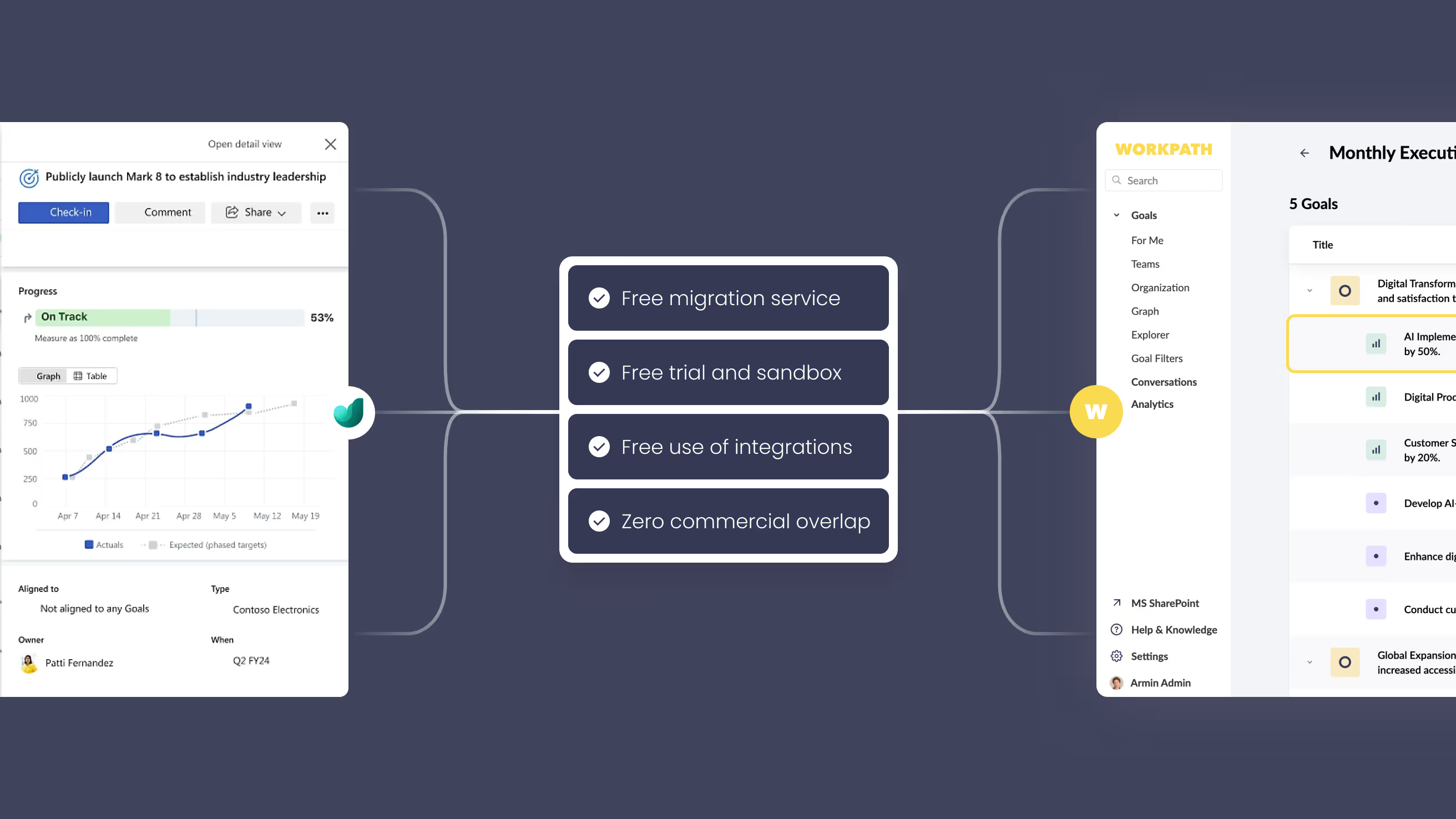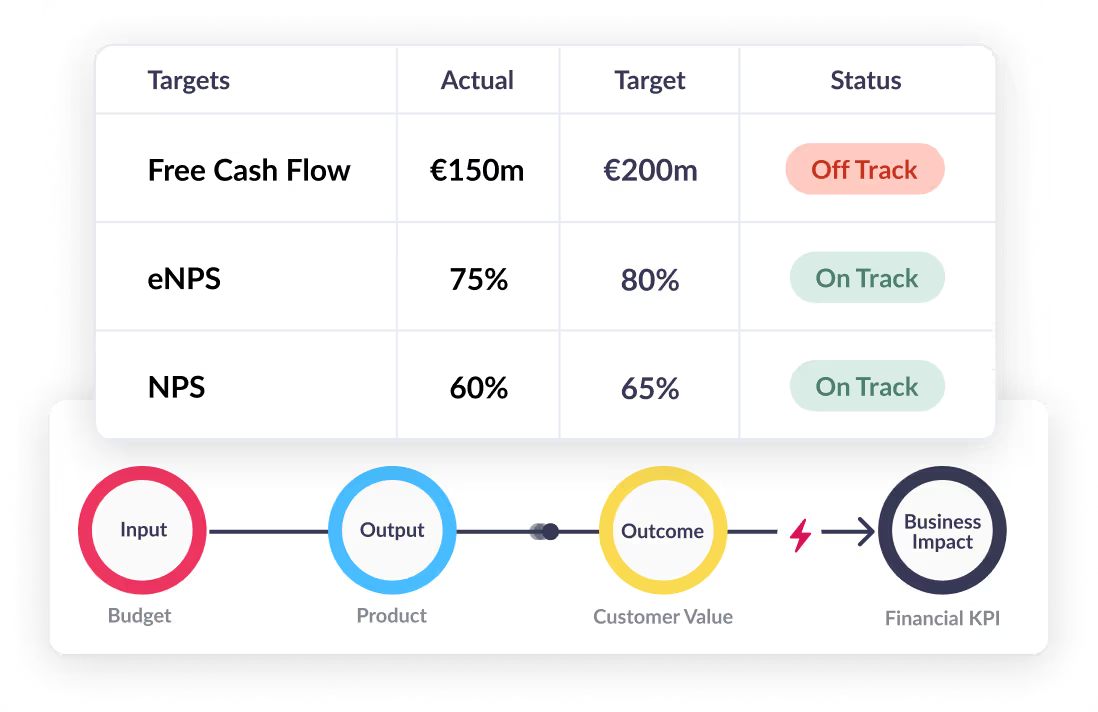Microsoft's decision to retire Viva Goals by December 31, 2025, has sent ripples through enterprise strategy departments worldwide. With development already halted as of December 2024, organizations using Viva Goals face an urgent need to identify and migrate to a sustainable alternative. This isn't just about finding another OKR tool—it's about securing a platform that can drive real strategic outcomes at enterprise scale.
For large organizations, particularly those in regulated industries across Europe, the stakes are high. You need more than basic goal tracking. You need enterprise-grade security, comprehensive Business Reviews, KPI integration, and the ability to connect strategy to execution across complex organizational structures. This guide evaluates the top alternatives through an enterprise lens, focusing on platforms that deliver measurable business impact while meeting stringent compliance requirements.
Why Organizations Are Leaving Viva Goals
While Viva Goals served as a functional OKR platform, enterprise users consistently encountered limitations that hindered strategic execution at scale. Understanding these gaps helps clarify what your next platform must deliver.
Limited Strategic Depth
Viva Goals focused primarily on OKR tracking without providing the comprehensive strategy execution capabilities enterprises require. There's no native support for impact chains—the critical connections between inputs, outputs, outcomes, and business impact. Without this visibility, executives struggle to understand how operational activities drive strategic results.
Business Review Gaps
Enterprise leadership relies on structured Business Reviews to steer portfolios and make data-driven decisions. Viva Goals lacks dedicated Business Review functionality, forcing teams into manual consolidation across spreadsheets and PowerPoint. This creates a reporting lag, increases error risk, and consumes valuable time that should be focuses on strategic discussions.
Integration and Data Sovereignty Constraints
For European enterprises, data residency is mandatory. Viva Goals offers no EU hosting options, creating compliance challenges for organizations bound by GDPR and industry-specific regulations. The platform's integration ecosystem, while Microsoft-centric, lacks depth with enterprise tools like SAP, limiting its utility for complex operational environments.
Framework Inflexibility
Modern enterprises employ various strategic frameworks—OKRs, Balanced Scorecards, SAFe/PI planning, or hybrid approaches. Viva Goals' rigid OKR-only structure forces organizations to adapt their proven methodologies to the tool rather than the tool supporting their strategic approach. This inflexibility particularly impacts organizations transitioning between frameworks or running parallel strategic initiatives.
Adoption and Support Challenges
Microsoft's decision to sunset Viva Goals reflects its "low adoption rates"—a telling indicator of user experience challenges. Enterprise teams reported steep learning curves, limited customization options, and insufficient support for change management. Without strong adoption, even powerful tools fail to deliver value.
What to Look for in an Enterprise Viva Goals Alternative
Selecting an enterprise strategy execution platform requires careful evaluation across multiple dimensions. Here's what distinguishes enterprise-ready solutions from basic OKR tools.
Enterprise Security & Compliance
Certifications Matter: Look for platforms with ISO 27001 certification as a baseline. For automotive and manufacturing sectors, TISAX certification demonstrates a commitment to industry-specific security standards. These aren't just badges—they represent audited processes that protect your strategic data.
Data Sovereignty and Residency: EU-based organizations must prioritize platforms offering data residency within the European Union. German hosting provides additional advantages under GDPR, offering some of the world's strictest data protection standards. Verify that data processing agreements align with your legal requirements and that the vendor maintains transparent data handling practices.
Access Controls and Audit Trails: Enterprise platforms must support granular role-based access controls, allowing you to segment strategic information appropriately. Comprehensive audit trails ensure accountability and support compliance reporting. Look for platforms that log all critical actions—goal modifications, KPI updates, and Business Review decisions.
Integration Capabilities
Microsoft Ecosystem Depth: While seeking Viva Goals alternatives, maintaining Microsoft integration remains crucial. Evaluate how deeply platforms integrate with Teams, Power BI, and Azure DevOps. Surface-level integrations that merely push notifications differ vastly from native experiences that enable full workflow execution within familiar tools.

Cross-Functional Tool Support: Strategy execution spans beyond Microsoft tools. Your platform should connect with Jira for product development, SAP for operations, and specialized BI tools for KPI automation. Assess whether integrations support bi-directional data flow, enabling real-time updates rather than manual syncs.
API Flexibility: Open APIs enable custom integrations with proprietary systems and emerging tools. Evaluate API documentation quality, rate limits, and support for webhooks. GraphQL APIs offer advantages over REST for complex data relationships common in enterprise environments.
Strategic Features
Beyond OKRs—Comprehensive Outcome Management: While OKRs provide structure, enterprises need platforms that connect multiple goal types—strategic objectives, operational KPIs, project milestones, and financial metrics. Look for platforms supporting "impact chains" that visualize how activities drive outcomes and ultimately business impact.
Business Review Orchestration: Structured Business Reviews drive enterprise performance. Your platform should automate review preparation, standardize templates across business units, and enable real-time executive dashboards. Features like automated variance analysis, risk flagging, and capacity management transform reviews from reporting exercises into strategic steering sessions.
AI-Powered Intelligence Modern platforms leverage AI beyond simple automation. Seek capabilities like intelligent goal drafting, quality scoring, alignment recommendations, and predictive analytics. However, ensure AI features maintain transparency and auditability—black box algorithms won't pass enterprise governance reviews.
Top 7 Enterprise Viva Goals Alternatives
1. Workpath - Best for Complete Enterprise Strategy Execution
Overview
Workpath stands apart as a comprehensive Enterprise Outcome Management platform designed specifically for large European organizations. Unlike tools that retrofitted enterprise features, Workpath built its platform around the complex realities of multinational strategy execution. The platform's "impact chain" methodology connects strategic goals through operational activities to measurable business outcomes, providing the visibility executives need to steer effectively.
Key Differentiators
Workpath's Business Review module transforms quarterly planning from spreadsheet chaos into structured, data-driven sessions. Real-time KPI integration with Power BI and proprietary systems ensures discussions focus on current performance, not outdated reports. The platform's unique contribution request system manages cross-functional dependencies, critical for matrix organizations where success requires orchestrated effort across departments.
The AI agents within Workpath go beyond basic automation. They actively improve OKR quality through contextual suggestions, flag misalignments before they become problems, and recommend course corrections based on historical patterns. This intelligence remains fully auditable—every AI recommendation includes explainable reasoning aligned with enterprise governance requirements.
Enterprise-Grade Security
Workpath provides complete EU data residency. ISO 27001 and TISAX certifications demonstrate automotive-grade security practices. The platform supports SSO via SAML 2.0, SCIM provisioning, and maintains SOC 2 Type II compliance. For organizations with specific compliance needs, Workpath offers detailed data processing agreements and supports customer-specific security audits.
Integration Excellence
Workpath's Microsoft integration runs deep. Within Teams, users access full functionality—not just notifications. The Power BI connector enables automated KPI updates, eliminating manual data entry. Jira and Azure DevOps integrations link delivery work to strategic outcomes, answering the perpetual question: "How does this sprint contribute to our objectives?"
Migration Support
Workpath provides white-glove migration service for enterprises leaving Viva Goals. The team handles data mapping, historical preservation, and user provisioning. The typical migration timeline spans 4-6 weeks, including parallel running to ensure seamless transition. Post-migration, customers receive dedicated Customer Success management and access to the Workpath Academy for ongoing enablement.

Best For
Large European enterprises in manufacturing, logistics, and technology sectors requiring comprehensive strategy execution with stringent compliance needs.
2. Quantive - Best for AI-Driven Strategy Management
Overview
Quantive StrategyAI has been known as an advanced strategy management platform, embedding AI throughout planning and execution. However, following its recent acquisition by WorkBoard, it will soon cease to exist as a standalone platform. Current users face a transition period, as Quantive’s capabilities are expected to be integrated into WorkBoard’s portfolio.
Strengths
The platform’s AI capabilities extend beyond automation to provide genuine strategic insights. Pattern recognition identifies successful goal structures from historical data, while predictive analytics forecast achievement probability based on leading indicators. Quantive also excelled at complex frameworks—from Balanced Scorecards to OKRs and custom methodologies—and its 170+ pre-built integrations supported enterprise-grade reporting.
Limitations
The platform’s power came with complexity. Implementation typically required 8–12 weeks with professional services support. More importantly, its AI features relied on substantial historical data to deliver meaningful insights—a challenge for organizations new to structured goal management. With WorkBoard’s acquisition, future support and feature continuity remain uncertain for existing Quantive customers.
Best For
Historically, large enterprises with mature data infrastructure seeking advanced analytics and AI-driven insights. Moving forward, prospective buyers should evaluate WorkBoard’s roadmap rather than Quantive as a standalone option.
3. WorkBoard - Best for Complex Distributed Organizations
Overview
WorkBoard has evolved from OKR software into a comprehensive strategy execution platform, with recent AI assistants "John" and "Sofia" adding intelligent automation. The platform excels at managing strategic complexity across distributed teams and matrix organizations.
Strengths
WorkBoard's strength lies in connecting strategy to operational execution. The platform handles intricate organizational structures—multiple reporting lines, virtual teams, and temporary initiatives. Its outcome-centered coaching methodology helps organizations shift from activity-focused to results-driven cultures.
The platform provides extensive analytics, including predictive achievement scoring and automated insight generation. Executive dashboards offer real-time visibility into strategic health, with drill-down capabilities to understand performance drivers.
Migration Considerations
WorkBoard lacks automated Viva Goals migration. Organizations must export data and manually recreate structures using WorkBoard's AI-assisted setup tools. While this allows for structure optimization, it extends migration timelines to 6-10 weeks for large enterprises.
Best For
Multinational corporations with complex organizational structures requiring sophisticated strategy-to-execution alignment.
4. Mooncamp - Best for Microsoft-Native Experience
Overview
Mooncamp positions itself as the natural Viva Goals successor for organizations committed to the Microsoft ecosystem. The platform delivers OKR management through native Microsoft experiences, minimizing change management requirements.
Strengths
Mooncamp's Microsoft integration feels native because it practically is—the platform leverages Microsoft's UI components and design language throughout. Users work within familiar interfaces, reducing adoption friction. The free migration service for Viva Goals customers includes data transfer, user setup, and parallel running support.
The platform balances simplicity with capability. While less feature-rich than enterprise platforms, Mooncamp covers essential OKR workflows effectively. Real-time synchronization with Microsoft tools ensures data consistency without manual updates.
Limitations
Mooncamp focuses on OKR management without broader strategy execution capabilities. Organizations requiring Business Reviews, portfolio management, or complex KPI hierarchies may find the platform limiting. EU data residency depends on Microsoft Azure regions, which may not meet specific compliance requirements.
Best For
Mid-market European companies seeking straightforward OKR management within the Microsoft ecosystem.
5. Profit.co - Best Value for Comprehensive Features
Overview
Profit.co delivers an all-in-one platform combining OKRs, KPIs, performance management, and employee engagement at competitive price points. The platform's breadth makes it attractive for organizations seeking consolidated tooling without enterprise pricing.
Strengths
Feature depth impresses at Profit.co's price point. The platform includes OKR management, KPI tracking, performance reviews, and task management—capabilities typically requiring multiple tools. The integrated approach reduces tool proliferation and simplifies user experience.
Profit.co provides solid migration support with dedicated assistance for Viva Goals transitions. Their customer success team guides organizations through data export, transformation, and import processes. The platform's flexibility accommodates various strategic frameworks, allowing organizations to maintain existing methodologies.
Considerations
While feature-rich, Profit.co's enterprise capabilities lag behind specialized platforms. Advanced security certifications, EU-specific hosting, and complex integration scenarios may require workarounds. The platform's broad scope occasionally results in UI complexity that impacts user adoption.
Best For
Cost-conscious organizations seeking comprehensive functionality without enterprise-tier pricing.
6. Perdoo - Best for OKR Simplicity
Overview
Perdoo embraces simplicity in OKR management, providing essential capabilities without overwhelming complexity. The platform's straightforward approach appeals to organizations prioritizing ease of use over advanced features.
Strengths
Perdoo's intuitive interface requires minimal training. The platform guides users through OKR best practices without forcing rigid workflows. Microsoft integrations, while basic, cover common use cases—Teams notifications, Power BI exports, and calendar synchronization.
The platform includes practical features like meeting management, 1:1 tracking, and engagement surveys. These additions support OKR adoption by embedding goal discussions into routine workflows. Pricing transparency—published rates with volume discounts—simplifies procurement.
Limitations
Perdoo's simplicity becomes limiting for complex enterprises. The platform lacks Business Review orchestration, advanced analytics, and sophisticated integration capabilities. Multi-entity organizations may struggle with Perdoo's flat organizational model.
Best For
Small to mid-market organizations seeking straightforward OKR implementation without enterprise complexity.
7. Lattice - Best for People-Centric Strategy
Overview
Lattice approaches strategy execution through a people lens, integrating OKRs with performance management, career development, and employee engagement. This holistic approach appeals to organizations viewing human capital as their primary strategic differentiator.
Strengths
Lattice excels at connecting individual performance to organizational outcomes. The platform's OKR module integrates seamlessly with performance reviews, ensuring goals inform evaluations. Career development features help employees understand how achieving OKRs advances their professional growth.
The platform's engagement surveys and analytics provide insights into organizational health—critical context for strategy execution. Lattice identifies correlation between engagement levels and goal achievement, enabling proactive interventions.
Considerations
Lattice's HR focus may not satisfy pure strategy execution needs. Organizations requiring detailed Business Reviews, portfolio management, or operational KPI tracking should evaluate whether Lattice's people-centric features justify potential gaps in strategic functionality.
Best For
Organizations prioritizing cultural transformation and employee engagement as strategic enablers.
Migration Roadmap: From Viva Goals to Your New Platform
Successfully migrating from Viva Goals requires structured planning and phased execution. This roadmap provides a framework adaptable to your chosen platform and organizational complexity.
Phase 1: Assessment & Selection
Begin immediately—waiting risks compressed timelines and hasty decisions. Document your current Viva Goals configuration: organizational structure, active OKRs, KPI definitions, integration points, and historical data requirements. Assess what works and what doesn't. This isn't just about replicating Viva Goals—it's an opportunity to optimize your strategy execution approach.
Engage stakeholders early. Survey users about pain points and wishlist features. Include IT for security assessments, HR for change management planning, and Finance for budgeting. Create a selection committee combining strategic and operational perspectives.
Request demonstrations from your shortlisted platforms. Insist on scenarios specific to your use cases—generic demos won't reveal platform limitations. Evaluate cultural fit alongside features. The best platform delivered poorly fails; an adequate platform with excellent support succeeds.
Phase 2: Data Export & Preparation
Export your Viva Goals data comprehensively—current goals, historical performance, organizational structures, and user information. Microsoft provides export options via API, Excel, and PowerPoint. Don't wait until the last minute; export capabilities may degrade as the sunset date approaches.
Clean and standardize your data. Remove obsolete goals, consolidate duplicate KPIs, and align terminology. This housekeeping, while tedious, prevents importing problems into your new platform. Document any custom fields or calculations requiring recreation.
Map data structures between platforms. Field names, data types, and relationships likely differ. Create transformation rules and test with sample data. This mapping becomes your migration blueprint, preventing surprises during cutover.
Phase 3: Platform Setup & Configuration
Configure your new platform methodically. Start with organizational structure—departments, teams, reporting lines. Establish user roles and permissions aligned with your governance model. Configure approval workflows for goal creation and modification.
Set up integrations prioritizing critical data flows. Test each integration thoroughly—a faulty Power BI connection discovered during quarterly reviews creates crisis. Document integration behaviors and establish monitoring procedures.
Customize the platform to match your terminology and workflows. If you call them "Strategic Initiatives" rather than "Objectives," configure accordingly. Small familiarity elements ease adoption significantly.
Phase 4: Pilot & Training
Run a controlled pilot with a representative group—mix early adopters with skeptics, executives with individual contributors. The pilot validates configuration and surfaces unexpected issues before broad rollout.
Develop role-specific training materials. Executives need different training than team leads or individual contributors. Create quick reference guides, video tutorials, and FAQs. Consider train-the-trainer approaches for large organizations.
Gather pilot feedback systematically. Daily check-ins during the first week identify immediate issues. Weekly surveys track adoption progress. Exit interviews with pilot participants provide comprehensive insights for refinement.
Phase 5: Full Rollout
Execute phased rollout by business unit or geography. This controlled approach allows focused support and iterative improvements. Maintain Viva Goals in read-only mode during transition—users need reference access to historical data.
Provide hypercare support during the initial weeks. Dedicated helpdesk, office hours, and floor walkers accelerate issue resolution. Quick wins build momentum; unresolved problems erode confidence.
Celebrate early successes publicly. Share stories of teams achieving goals, executives gaining insights, or processes improving. Success stories from peers resonate more than vendor promises.
Phase 6: Optimization & Adoption
Monitor adoption metrics closely—login frequency, goal updates, feature utilization. Low engagement signals require intervention. Address adoption gaps with targeted training or process adjustments.
Optimize based on usage patterns. If teams struggle with monthly check-ins, consider bi-weekly cadences. If KPI updates lag, investigate integration issues. Continuous refinement transforms good implementations into great ones.
Conduct retrospectives before Viva Goals' final shutdown. Document lessons learned, archive any remaining data, and ensure all stakeholders confirm readiness for cutover. End with confidence, not scrambling.
Why Workpath Stands Out for Enterprise Strategy Execution
While each platform offers unique strengths, Workpath's comprehensive approach to enterprise strategy execution deserves deeper examination—particularly for European organizations facing complex compliance and integration requirements.
The Impact Chain Advantage
Workpath's impact chain methodology transcends traditional goal hierarchies. By explicitly linking inputs (resources, initiatives) through outputs (deliverables, milestones) to outcomes (strategic goals) and ultimately business impact (revenue, cost, quality), organizations gain unprecedented visibility into value creation.

The visual representation of impact chains reveals dependencies and bottlenecks invisible in traditional OKR trees. When a key result falls behind, executives immediately see affected outcomes and can reallocate resources proactively. This systemic view transforms strategy from static plans into dynamic systems.
Business Reviews That Drive Decisions
Workpath's Business Reviews eliminates the quarterly scramble of consolidating spreadsheets and crafting PowerPoint narratives. Standardized templates ensure consistency across business units while allowing customization for specific contexts. Real-time KPI integration means discussions focus on current performance, not last month's snapshot.
The platform automatically generates executive summaries, variance analyses, and risk assessments. AI-powered insights highlight anomalies and trends requiring attention. But automation doesn't replace judgment—it amplifies it by freeing leaders to focus on strategic decisions rather than data gathering.

German Engineering Meets Data Sovereignty
Workpath's German heritage isn't just about location—it reflects engineering philosophy. The platform demonstrates the thoroughness, reliability, and attention to detail associated with German enterprise software. Every feature undergoes rigorous testing; every integration follows enterprise-grade standards.
Data sovereignty goes beyond compliance checkboxes. With national servers, data never leaves German jurisdiction. This matters for regulated industries where data location affects legal liability. TISAX certification—rare among strategy platforms—demonstrates automotive-grade security practices essential for manufacturing clients.
Professional Enablement Services
Workpath's services go beyond platform guidance. The curriculum covers strategy execution methodology, OKR best practices, and AI trainings. Certification programs develop internal champions who sustain adoption long after implementation.
Consulting services help organizations optimize their operating models before platform configuration. This strategic alignment ensures technology amplifies good practices rather than automating poor ones. The staged approach—assessment, design, implementation, optimization—reduces risk while accelerating value realization.
Decision Framework: Choosing Your Viva Goals Alternative
Selecting the right platform requires an honest assessment of your organization's maturity, requirements, and constraints. This framework guides your evaluation process.
Quick Assessment Questions
Strategic Maturity
- Do you have established strategic planning processes, or are you building them?
- Are OKRs your primary framework, or do you employ multiple methodologies?
- How sophisticated are your current Business Review processes?
Organizational Complexity
- How many entities, business units, and teams require coordination?
- Do you operate matrix structures with multiple reporting lines?
- What percentage of work crosses functional boundaries?
Technical Requirements
- Which systems must integrate with your strategy platform?
- What security certifications do your policies mandate?
- Where must your data reside for compliance?
Change Capacity
- How much change can your organization absorb simultaneously?
- What internal resources exist for training and support?
- How critical is user adoption speed versus feature completeness?
Scenario-Based Recommendations
Scenario 1: Large European Manufacturing Enterprise
If you're a 10,000+ employee manufacturer with TISAX requirements, complex supply chains, and established SAFe processes, Workpath provides the comprehensive capabilities and compliance credentials you need. The platform's impact chains align with manufacturing's input-output thinking, while German hosting satisfies stringent data requirements.
Scenario 2: Fast-Growing Technology Company
For rapidly scaling tech companies with distributed teams and agile cultures, WorkBoard offers the flexibility to handle organizational fluidity. Its AI capabilities help maintain alignment despite constant change, though you'll need to manage manual migration carefully.
Scenario 3: Microsoft-Centric Organization
If your organization lives within Microsoft 365 and values seamless integration over advanced features, Mooncamp delivers familiar experiences with minimal disruption. Ensure its OKR-focused approach satisfies your strategic requirements before committing.
Scenario 4: Cost-Conscious Multi-Framework Organization
Organizations balancing multiple strategic frameworks with budget constraints should evaluate Profit.co. Its all-in-one approach consolidates tool costs while supporting diverse methodologies, though enterprise features may require compromise.
Red Flags to Avoid
Vendor Viability: Investigate vendor financial stability and market position. Another sunset scenario would be catastrophic. Look for established companies with diverse revenue streams or strong funding positions.
Hidden Complexity: Beware platforms requiring extensive professional services for basic functionality. While complex implementations sometimes justify support, core features should be self-service accessible.
Integration Limitations: Verify integration depth, not just availability. A checkbox claiming "Jira integration" might mean anything from full bi-directional sync to basic webhook notifications. Test actual workflows during evaluation.
Adoption Barriers: If pilot users struggle despite training, broader adoption will fail. Complexity that seems manageable during vendor-led demonstrations becomes overwhelming in daily use.
Conclusion & Next Steps
The Viva Goals retirement deadline—December 31, 2025—approaches faster than most organizations anticipate. With development already ceased, waiting risks finding yourself in a reactive scramble rather than strategic transition. The time for action is now.
Your choice extends beyond replacing an OKR tool. You're selecting the platform that will orchestrate strategy execution for years ahead. This decision impacts how effectively you translate strategic intent into operational reality, how quickly you identify and respond to performance gaps, and ultimately, how successfully you achieve your organizational objectives.
For enterprises requiring comprehensive strategy execution—not just goal tracking—Workpath offers a proven path forward. Our impact chain methodology, integrated Business Reviews, and enterprise-grade security provide the foundation for sustainable strategic excellence. With successful implementations at organizations like Bosch, SAP, and DB Schenker, we understand the complexities of enterprise transformation.
Take action today. Schedule a personalized demonstration to see how Workpath addresses your specific requirements. Our migration specialists will assess your Viva Goals configuration and develop a customized transition plan. With our Launch Kit, you can pilot Workpath with up to 100 users while maintaining Viva Goals in parallel—eliminating risk while building confidence.
Don't let the Viva Goals sunset disrupt your strategic momentum. Transform this challenge into an opportunity to elevate your strategy execution capabilities. Access our migration toolkit here, including readiness assessments, data export templates, and transition timelines.
The question isn't whether to migrate from Viva Goals—that decision has been made for you. The question is whether you'll use this transition to merely maintain the status quo or to fundamentally improve how your organization executes strategy. The choice, and the opportunity, is yours.
Frequently Asked Questions About Migrating from Viva Goals
When is Microsoft Viva Goals shutting down?
Microsoft Viva Goals will officially retire on December 31, 2025. Development and new features have already stopped as of December 2024. Organizations using Viva Goals should begin migration planning immediately, as Microsoft will not extend the sunset date and support will gradually decrease throughout 2025.
How do I export my data from Viva Goals?
Microsoft provides three methods to export your Viva Goals data: via API for automated extraction, through Excel downloads for structured data, and PowerPoint exports for presentation materials. Export your data as soon as possible—don't wait until close to the sunset date, as export capabilities may become unreliable. Include current OKRs, historical performance data, organizational structures, user information, and any custom configurations.
How long does it take to migrate from Viva Goals to a new platform?
Enterprise migrations typically take 12-16 weeks from selection to full adoption. The timeline breaks down as: 2-3 weeks for platform evaluation and selection, 2-3 weeks for data export and preparation, 3-4 weeks for platform configuration and integration setup, 2-3 weeks for pilot testing and training, and 3-4 weeks for phased rollout. Organizations with under 500 users may complete migration in 6-8 weeks, while complex enterprises with multiple business units may require up to 20 weeks.
What is the best alternative to Viva Goals for European enterprises?
For European enterprises, Workpath stands out with its German data centers, ISO 27001 and TISAX certifications, and comprehensive GDPR compliance. The platform offers complete EU data residency, ensuring data never leaves German jurisdiction. Other EU-compliant alternatives include Perdoo (EU hosting) and Mooncamp (Azure EU regions), though they lack the enterprise-grade certifications and comprehensive Business Review capabilities that Workpath provides.
Can I keep using Microsoft Teams with Viva Goals alternatives?
Yes, most enterprise OKR platforms maintain Microsoft Teams integration. Workpath provides native Teams functionality—not just notifications but full platform access within Teams. Mooncamp delivers the most Microsoft-native experience with UI components matching Teams' design language. Quantive, WorkBoard, and Profit.co offer Teams integrations for notifications and basic workflows. Verify integration depth during evaluation, as "Teams integration" can range from simple alerts to complete embedded functionality.
What features should I look for in a Viva Goals replacement?
Essential features for enterprise Viva Goals replacements include: OKR and KPI management with real-time tracking, Business Review orchestration for quarterly planning, integration with Microsoft 365 and enterprise tools like Jira, role-based access controls with audit trails, automated reporting and executive dashboards, AI-powered goal drafting and quality checks, and professional migration support. Advanced enterprises should also seek impact chain visualization, portfolio management capabilities, and multi-framework support beyond just OKRs.
Do Viva Goals alternatives support frameworks beyond OKRs?
Yes, several platforms support multiple strategic frameworks. Workpath enables OKRs, KPIs, Balanced Scorecards, and SAFe/PI planning within one platform. Quantive StrategyAI accommodates virtually any strategic framework with customizable structures. WorkBoard supports OKRs alongside project portfolios and strategic initiatives. However, some alternatives like Mooncamp and Perdoo focus primarily on OKRs. Evaluate whether you need framework flexibility or prefer specialized OKR functionality.
What migration support do vendors provide for Viva Goals customers?
Migration support varies significantly by vendor. Workpath provides white-glove service including data mapping, historical preservation, parallel running, and dedicated customer success management. Quantive offers automated 1:1 migration tools specifically for Viva Goals customers. Mooncamp advertises free migration service including data transfer and setup assistance. WorkBoard requires manual migration but provides AI-assisted setup tools. Most vendors include training, documentation, and implementation support in enterprise packages.
How do I maintain data security during migration?
Ensure data security during migration by: selecting vendors with ISO 27001 certification and appropriate compliance credentials, using encrypted data transfer methods (SFTP, encrypted APIs), signing data processing agreements before sharing any information, conducting security audits of the new platform, maintaining audit logs of all data exports and imports, and running parallel systems during transition to ensure no data loss. Never transfer sensitive strategic data through unsecured channels or personal email accounts.
Can we run Viva Goals and a new platform in parallel?
Yes, running platforms in parallel is recommended during migration. Most organizations maintain Viva Goals in read-only mode while building out their new platform. This approach allows teams to reference historical data, validate data accuracy in the new system, train users without disrupting operations, and ensure smooth transition without gaps. Plan for 4-8 weeks of parallel running, though this increases to 12 weeks for complex enterprises requiring phased rollouts.
What happens to our historical OKR data from Viva Goals?
Historical data preservation depends on your chosen platform and migration approach. Workpath imports up to 3 years of historical OKR data, maintaining performance trends and achievement records. Most platforms can import at least 12 months of history. Some organizations choose to archive historical data separately for compliance while starting fresh in the new platform. Ensure your data retention policies are satisfied before completing migration.
Which Viva Goals alternative has the best AI capabilities?
Workpath's AI agents excel at maintaining auditability—every recommendation includes explainable reasoning aligned with enterprise governance. WorkBoard's AI assistants "John" and "Sofia" provide conversational interfaces for goal management. For enterprises requiring transparent, auditable AI that supports compliance requirements, Workpath's approach balances intelligence with accountability.
How do we ensure user adoption when switching from Viva Goals?
Successful adoption requires structured change management: involve key stakeholders in platform selection to build buy-in, provide role-specific training rather than generic overviews, identify and empower champions in each department, celebrate early wins and success stories publicly, maintain hypercare support during initial weeks, and gather continuous feedback for iterative improvements. Platforms with intuitive interfaces like Perdoo and Mooncamp see faster adoption, while comprehensive platforms like Workpath benefit from professional enablement services.
What are the risks of delaying Viva Goals migration?
Delaying migration creates multiple risks: compressed timelines leading to rushed decisions and poor platform selection, reduced vendor support as Viva Goals sunset approaches, potential data export issues near the deadline, insufficient time for proper training and adoption, and disrupted Q4 2025 planning cycles if migration isn't complete. Organizations should begin evaluation by Q1 2025, select platforms by Q2, and complete migration by Q3 to avoid year-end complications.



.png)




